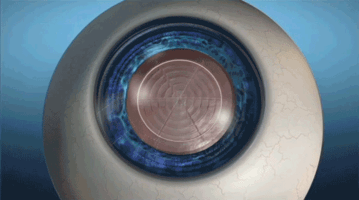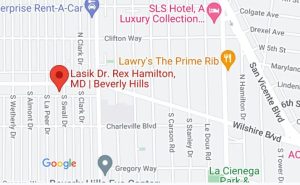Cataract Experience
As a leader in the field of cataract surgery for the last fifteen years, Dr. Rex Hamilton stays on the cutting-edge of the newest developments and technologies available to cataract surgeons. Dr. Hamilton began using lasers for cataract surgery in 2010, was the first faculty member at the Stein Eye Institute to implement laser cataract surgery and has trained numerous ophthalmic surgeons on the art and science of this amazing technology. Dr. Rex Hamilton is proud to offer the latest in cataract technology that takes advantage of laser and other advances, maximizing your outcome while minimizing the risks and side-effects. The package makes use of two amazing technologies: Femtosecond Laser Assisted Cataract Surgery (FLACS) and Intraoperative Aberrometry (ORA). Schedule an appointment with our office in Beverly Hills today to find out more.
Cataract
In Beverly Hills, Los Angeles, CA
Cataract Experience
As a leader in the field of cataract surgery for the last fifteen years, Dr. Rex Hamilton stays on the cutting-edge of the newest developments and technologies available to cataract surgeons.
Dr. Hamilton began using lasers for cataract surgery in 2010, was the first faculty member at the Stein Eye Institute to implement laser cataract surgery and has trained numerous ophthalmic surgeons on the art and science of this amazing technology.
Dr. Rex Hamilton is proud to offer the latest in cataract technology that takes advantage of laser and other advances, maximizing your outcome while minimizing the risks and side-effects.
The package makes use of two amazing technologies: Femtosecond Laser Assisted Cataract Surgery (FLACS) and Intraoperative Aberrometry (ORA). Schedule an appointment with our office in Beverly Hills today to find out more.


Cataract Surgery
What Our Patients Say


LENSAR ALLY Femtosecond Laser
What is Femtosecond Laser Assisted Cataract Surgery (FLACS)?
A FLACS system is a device that places very short duration pulses of laser energy onto exact, targeted locations within the eye to carry out certain steps of the premium cataract extraction procedure. The word “femtosecond” refers to a unit of time one millionth of one billionth of a second. These laser pulses can be arranged and patterned in a customized way to create a precisely shaped incision through transparent tissues such as the cornea and the cloudy lens (cataract) inside the eye.
Prior to using the laser, the system collects high resolution images of the intricate, anatomic structures that make up the front portion of your eye. Then, based on these images, Dr. Rex Hamilton precisely defines the placement of the laser pulses to create incisions within various eye structures (e.g. cornea, cataract) without the use of physical surgical instruments. This improves the overall accuracy and safety of the procedure, increasing the chance of achieving the outcome you and Dr. Hamilton desire.

LENSAR ALLY Femtosecond Laser
What is Femtosecond Laser Assisted Cataract Surgery (FLACS)?
A FLACS system is a device that places very short duration pulses of laser energy onto exact, targeted locations within the eye to carry out certain steps of the premium cataract extraction procedure.
The word “femtosecond” refers to a unit of time one millionth of one billionth of a second.
These laser pulses can be arranged and patterned in a customized way to create a precisely shaped incision through transparent tissues such as the cornea and the cloudy lens (cataract) inside the eye.
Prior to using the laser, the system collects high resolution images of the intricate, anatomic structures that make up the front portion of your eye.
Then, based on these images, Dr. Rex Hamilton precisely defines the placement of the laser pulses to create incisions within various eye structures (e.g. cornea, cataract) without the use of physical surgical instruments.
This improves the overall accuracy and safety of the procedure, increasing the chance of achieving the outcome you and Dr. Hamilton desire.
Following the FLACS procedure, Dr. Hamilton will remove the cataract from the eye and place the intraocular lens implant. This is achieved using a system known as phacoemulsification. This technique, developed and refined over the past 40+ years, makes use of ultrasonic energy to break up a cataract and aspirate (i.e. vacuum) it out of the eye through a small, 2.4 mm incision. The FLACS laser can be used to make a precise opening in the capsule containing the cataract, divide the cataract into smaller pieces, facilitating their removal, and to make precise incisions in the cornea to reduce astigmatism.

Johnson & Johnson Vision’s CATALYS® Femtosecond Laser

Johnson & Johnson Vision’s CATALYS® Femtosecond Laser
Following the FLACS procedure, Dr. Hamilton will remove the cataract from the eye and place the intraocular lens implant. This is achieved using a system known as phacoemulsification.
This technique, developed and refined over the past 40+ years, makes use of ultrasonic energy to break up a cataract and aspirate (i.e. vacuum) it out of the eye through the small, 2.4 mm incision created by the FLACS system.
Many steps in the phacoemulsification procedure are still performed manually, however, with either a surgical blade or forceps, without the imaging guidance offered by FLACS.
Through imaging guidance, incisions are more precise and reproducible than those made using a manual technique.
Ready to see the world more clearly?
Ready to see the world more clearly?
Astimgatic Keratotomies with a Femtosecond Laser

Through imaging guidance, these laser incisions are precise in their depth, width and location, based on your unique anatomy. The goal of these incisions is to round out the cornea, minimizing post-operative astigmatism and provide the best visual outcome. Dr. Hamilton has performed thousands of astigmatic keratotomies manually using a diamond blade but the depth, width and location of these manual incisions is not as precise as those placed using FLACS under imaging guidance.
What is Intraoperative Aberrometry (ORA)

Once Dr. Hamilton has removed the cataract from your eye, he needs to decide on the power of the intraocular lens implant (IOL) that will be inserted into the eye, replacing the cataract. Dr. Hamilton is extremely skilled in the art of IOL power selection using advanced power calculations based on measurements done in the office in Beverly Hills, Los Angeles prior to surgery. The anatomy of each individual eye is unique, however, leading to a chance that the IOL power selected may not be optimal. When Dr. Hamilton uses the laser for cataract surgery, he makes use of an additional tool to add a level of precision to the IOL power choice.
The Optiwave Refractive Analysis system (or ORA for short) allows for optical measurements to be taken during the surgery, after the cataract has been removed. In conjunction with pre-operative calculations done by Dr. Hamilton, the ORA system provides a very precise measure of the eye’s optics, allowing for improved accuracy of the lens power choice as well as for assessing the level of astigmatism.
How does using ORA during the surgery benefit me?
IOL power selection
After the cataract has been removed, Dr. Hamilton will ask you to look at a flashing light. The ORA system will then take 40 optical measurements of the eye in 2 seconds. Advanced computer algorithms then display various power options to Dr. Hamilton. This allows him, together with his pre-operative measurements and years of experience, to make the optimal power choice for your eye.
Treating Astigmatism

The ORA Camera
In addition to helping with IOL power selection, the ORA system assists Dr. Hamilton in treating your astigmatism. If your astigmatism is relatively low, Dr. Hamilton will have used the FLACS system to precisely place incisions at specific locations in the cornea. After analyzing the ORA results for astigmatism, Dr. Hamilton can decide if he needs additional astigmatism correction by opening the astigmatic incisions.
Using ORA for Astigmatism

Sometimes simply the placement of the laser incisions, without opening them, is sufficient to correct the astigmatism and they do not have to be opened. By using the ORA system, Dr. Hamilton can titrate his treatment and be more precise in reducing your astigmatism.
Using ORA for Toric Alignment

If you have a higher amount of astigmatism and Dr. Hamilton has elected to implant a Toric IOL, The ORA system will display an overlay through the microscope, showing real-time measurements of the astigmatism. As Dr. Hamilton rotates the Toric IOL into position, the ORA system assists him in placing the Toric in the precise orientation to maximally reduce your astigmatism.
Because Toric lenses are extremely sensitive to small amounts of misalignment, the visual aid assists Dr. Rex Hamilton in making the most of the lens’s capability. Likewise, the ORA also provides an interface for patients who are having an astigmatic keratotomy.
Get in Touch to Schedule a Consultation
Give us a call at: (424) 732-2020 or complete the form below to request a vision consultation to get started.
Refractive Lens Exchange Beverly Hills, Los Angeles, CA
Frequently asked questions
What is a cataract?
A cataract is a clouding of the natural lens of the eye, typically caused by aging, that can lead to blurry vision and decreased visual acuity.
How is cataract surgery performed?
Cataract surgery involves removing the cloudy natural lens and replacing it with a clear artificial intraocular lens (IOL) to restore vision.
Am I a candidate for cataract surgery?
Candidates for cataract surgery are individuals whose cataracts have progressed to the point of significantly impacting daily activities and quality of life. An eye examination by an ophthalmologist can determine candidacy.
What are the types of intraocular lenses (IOLs) available?
There are different types of IOLs available for cataract surgery, including monofocal, multifocal, and toric lenses. These lenses can correct vision at various distances and address astigmatism.
Is cataract surgery safe?
Yes, cataract surgery is considered a safe and routine procedure with a high success rate. Complications are rare, and most patients experience improved vision afterward.
What should I expect after cataract surgery?
After cataract surgery, patients typically experience improved vision within a few days as the eye heals. It’s common to have some mild discomfort or sensitivity initially, but this resolves quickly for most people.










